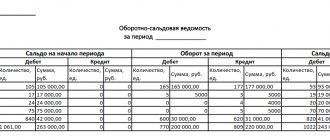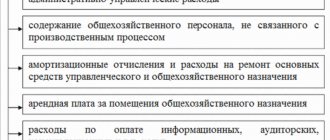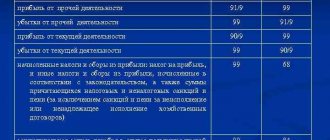To produce any type of product, resources are required - raw materials, semi-finished products, fuel. Materials are purchased at the expense of the organization, received, put into production, where they in one way or another participate in the creation of goods for sale and subsequent profit for the manufacturer. Materials are a significant expense item when calculating product costs. The manufacturer independently calculates the norms for writing off materials for the cost of goods, depending on the technical conditions approved at the enterprise, and prescribes an algorithm for accounting and writing off materials in the accounting policy. The economic department at the enterprise prepares cost estimates for the manufacture of finished products, indicating in them the quantity and cost of materials necessary for the manufacture of products. When purchasing materials, the manufacturer brings them to the warehouse, and the storekeeper is responsible for the safety of the materials in the warehouse. Warehouse premises must be equipped in such a way as to eliminate the risk of theft, damage or loss of materials as a result of technical problems or natural disasters. At the request of the manager, raw materials are supplied to the workshops, the head of the production site monitors the consumption of resources, preventing excess consumption of materials at work sites. The accountant takes into account the purchase of materials, their movement to the production site and the write-off of materials according to expense items, which have different effects on the tax base. The law does not provide for limits on the write-off of materials, since this depends on the specifics of each specific production, but the Ministry of Finance recommends that manufacturers confirm the actual consumption of materials with calculation data. A production site is a complex mechanism, departments and divisions interact here, and a large number of people work here. And there are cases when, due to the fault of the human factor, materials have to be written off in excess of norms as a result of theft, intentional or accidental damage. Nature itself makes adjustments to the write-off of materials and even products already ready for shipment. As a result of emergencies caused by uncontrollable natural disasters, warehouses suffer from fires and floods. As a result, the manufacturer is faced with the problem of writing off materials that were not involved in production, but became part of the company's costs. If you write off the cost of materials as expenses, income tax will decrease, and this will be of interest to the tax inspector. How to write off materials without reducing profits? Does writing off materials affect the loss? How to confirm the write-off of materials for income tax purposes, so as not to violate the law and not turn out to be an unprofitable enterprise? Let's look at how specific cases of writing off materials and finished products reduce income tax.
How to formalize and record the use of net profit
Net profit can be distributed only by decision of the organization's owners (participants, shareholders). This rule applies to both LLCs and joint stock companies (subclause
3 p. 2 art. 67.1, paragraph 4 of Art. 66 Civil Code of the Russian Federation). In an LLC, the decision on the distribution of net profit is documented in the minutes of the general meeting of participants (clause 1, article 28, clause 6, article 37 of the Law of February 8, 1998
No. 14-FZ). There are no mandatory requirements for the minutes of the general meeting of LLC participants in the legislation. But there are details that are better to indicate.
This is the number and date of the minutes, place and date of the meeting, agenda items, signatures of participants. In a joint stock company, minutes of the general meeting of shareholders are drawn up. It differs from the minutes of the general meeting of LLC participants in that it is drawn up in two copies and has mandatory details. They are listed in paragraph 2 of Article 63 of the Law of December 26, 1995 No. 208-FZ and paragraph 4.29 of the Regulations approved by order of the Federal Financial Markets Service of Russia dated February 2, 2012.
Write-off of the shortage at the expense of the net profit of the posting
Contents At least once a year, every organization carries out an operation called “inventory”. And in the course of it, a shortage of one or another property is often discovered.
This situation is not pleasant, because the company management and accountant will have to do a lot of work to find the perpetrators and compensate for the damage. There may also be a situation when the manager is ready to forgive the employee for a small mistake. However, this could backfire for a goodwill enterprise.
What should you be prepared for? Of course, it is not always possible to blame the materially responsible person for the shortage, for example, if inventory assets are subject to such a phenomenon as natural loss.
In this case, the accountant simply needs to write off the shortage by posting: Dt 20, 23, 44 - Kt 94 - writing off the cost of inventory items within the limits of natural loss. But this posting is only suitable for reflecting shortages within the standards.
Disposal of packaging with a logo
To ensure the safety of goods during transportation and the convenience of storing and unloading, the manufacturer uses containers. These can be disposable and reusable boxes, pallets, bottles, containers, etc. When concluding an agreement, the parties agree on the terms and conditions for the return of reusable containers. If the container is non-returnable under the terms of the contract, then the manufacturer writes it off in full as expenses, reducing income tax. What if, for advertising purposes, the manufacturer used images or advertising inscriptions on the container? Are such expenses considered expenses for advertising purposes, and should they be rationed? It all depends on the subjective opinion of the tax authority representative. The manufacturer may decide to completely write off the cost of manufacturing such containers as expenses, if necessary, challenging the tax authorities’ decision to introduce rationing in court. Income tax is reduced by writing off the cost of packaging with the Company logo, taking into account the rationing of expenses for advertising purposes.
Write-off entries from profit and loss
Calculations for taxes and fees." At the end of the month, the total account balance is calculated. 99, if the final balance is debit, the organization is at a loss this month, if it is a credit, it is in profit.
At the beginning of each month, the balance of account 99 is transferred from the previous month to the current month. Throughout the year, the balance of profits or losses accumulates in account 99 on an accrual basis. At the end of the year 99 is closed with final entries on the account.
84 “Retained earnings (uncovered loss).” Postings for closing the account 99 • D99 K84 - final financial result - profit. • D84 K99 - final financial result - loss.
At the beginning of next year. 99 opens again. As a result, on the account. 84, either profit (on credit) or loss (on debit) is reflected at the end of the year.
Account 84 is used to distribute profits for any needs of the organization, for example, for payments to founders. Also, if previously on the account.
How to “spend” your net profit correctly
At the same time, joint-stock companies are obliged to transfer part of the emergency fund to the reserve fund, and LLCs can do this if they wish; .
Shareholders (participants) can distribute the remaining profit at their own discretion. So, subject to certain conditions, they can use profits to pay dividends; . . . And sometimes owners decide to use emergency funds to purchase new operating systems or pay bonuses to employees. But the Laws on JSC and LLC do not say how to reflect the distribution of NRP in accounting in these cases.
To understand this issue, let's first talk about what IUU fishing is from a reporting point of view. Retained earnings are part of the organization’s capital; it is reflected in Section III “Capital and Reserves” of the balance sheet.
We recommend reading: What is the fine if you don’t have car insurance?
The standards establish rules only for the recognition of assets and liabilities, and capital is the arithmetic difference between them. There are no capital accounting rules in either RAS or IFRS.
New in accounting for expenses and net profit
Accounting, taxation, reporting, IFRS, analysis of accounting information, 1C: Accounting
We recommend reading: Negative reference for an employee from the place of work, sample for court
05/23/2001 subscribe to our channel The new chart of accounts provides for a slightly different procedure for recording organizational expenses and accounting for net profit than was the case until recently.
In this article, Professor of the St. Petersburg Trade and Economic Institute Viktor Vladimirovich Patrov talks about these changes, and also proposes a new methodology for accounting for net profit.
The article was provided by SPUTNIK-101, St. Petersburg. Until recently, all expenses of an organization were reflected in accounting in three ways: Until recently, all expenses of an organization were reflected in accounting in three ways: 1. Capitalization (inclusion of expenses in the value of an asset); 2.
Write-off to profit and loss account; 3.
Write-off of materials due to net profit posting
Contents Retained earnings (uncovered loss).”
The total balance of this account at the time of acquisition does not change. Investments by themselves at the expense of net profit do not lead to a decrease in the balance sheet currency. Debit 84.1 “Profit to be distributed” Credit 84.3 “Retained earnings in circulation” - shareholders decided to use net profit for production development; Debit 08 Credit 60 - reflects the costs of purchasing fixed assets; Debit 19 Credit 60 - VAT on the cost of the fixed asset is taken into account; Debit 01 Credit 08 - fixed asset accepted for accounting; Debit 84.3 “Retained earnings in circulation” Credit 84.4 “Retained earnings used” - net profit was actually directed (used) to the purchase of fixed assets; Debit 20, 25, 26 Credit 02 - depreciation accrued.
According to paragraph 1 of Art. Example: Turnover of Buttercup LLC for 2014: Account Dt, thousand.
Retained earnings of an organization: 3 options for where to write it off
The credit of account 84 shows the amount of net profit that was received for the entire period of the company’s activities, and not just according to data for the last year.
This value is the final result of the organization’s activities over the entire period of its existence. The owners have the right to use this accumulated profit at their discretion. Based on the credit balance of account 84, it can be determined whether the organization’s profit was not used to withdraw funds from circulation.
The manual “Calculating retained earnings is quite simple. For him, it is enough to substitute the values into one of the formulas indicated below, while knowing the amount of net profit/loss of the organization. To calculate retained earnings, a company needs to know and take into account the following indicators: retained earnings at the beginning of the period under review, net profit (Net Income or Net Profit) or net loss (Net Loss) and the amount of dividends paid.
Postings for writing off materials in accounting
Materials are one of the most important components in the cost of manufactured products, so they must be capitalized in a timely manner and the correct write-off must be monitored.
Let's consider the accounting entries generated when materials are written off for production, shortages, damage and gratuitous transfer.
Materials are current assets that are used in production as a resource element. Materials should be understood as a whole group of assets that can be used in production, namely semi-finished products, raw materials, fuel, components (spare parts) and other goods and materials for industrial purposes. To account for materials, account 10 “Materials” is used, which is intended for analytical accounting by type of inventory.
This account is active, so all receipts are displayed as a debit, and write-offs as a credit.
Material accounting has the following objectives:
Postings for materials and inventory items (10th account)
In accounting, postings to account 10 (Materials) play an important role. The cost of production and the final result of any type of activity - profit or loss - depend on how correctly and timely they were capitalized and written off. In this article we will look at the main aspects of accounting for materials and posting them.
These nomenclature groups include assets that can be used as semi-finished products, raw materials, components and other types of inventory assets for the production of products and services, or used for the own needs of an organization or enterprise. Control of their safety Reflection in accounting of all business transactions related to the movement of goods and materials (for cost planning and management and financial accounting) Formation of cost (materials, services, products).
Control of standard stocks (to ensure a continuous cycle of work)
Materials after dismantling
New technologies and the development of the machine tool industry encourage manufacturers to constantly modernize production, and large production facilities continue to dismantle obsolete equipment. As a result of dismantling, dismantled spare parts of fixed assets that have been disassembled appear, as well as materials that do not belong to fixed assets. If the manufacturer does not want to recycle anything, since they can still be used, the company’s accountant sends spare parts and other materials. Then it takes them into account as non-operating income and writes off the full cost of dismantled items in tax expenses. The cost of materials and spare parts during capitalization and write-off remains unchanged. For an enterprise, income tax in this case will be reduced. By the way, if the accountant did not write off the cost of the dismantled items in the period when the dismantling was carried out, it is permissible to do this in the period when the omission was discovered. No clarification is needed. Income tax is reduced by writing off the cost of materials capitalized during dismantling.
Accounting entries for writing off materials for production, damage, sale
Materials are the main element of current assets, which are used as an intermediate element in the activities of the organization. Let's look at the write-off of materials for production, sale and damage.
to the organization is maintained at the actual purchase price (without). Consumption of materials from the warehouse by production or managers of the organization is their internal movement. When materials are disposed of or consumed in production, accounting is carried out using the following methods:
- FIFO (first-in-first-out)
- Piece by piece
- Weighted average price
We recommend reading: State duty for temporary registration at the place of residence of foreign citizens
Postings: Account Debit Account Credit Description Amount Document-basis Materials transferred to main production cost Limit-fence card Requirement-invoice Invoice To auxiliary production cost cost For general production needs cost cost For general economic needs cost cost Materials can be:
Disposal of expired products
The laws of the Russian Federation prohibit the sale of expired products in order to preserve the life and health of consumers. If such goods are discovered, the company is obliged to conduct an inventory, remove the products from the warehouse and dispose of them. Is it possible to take into account the cost of disposed goods and the costs of their disposal as expenses that reduce income tax and how does writing off goods affect profit? Does the company need to restore VAT that was previously accepted for deduction? The expenses incurred by the organization in order to generate income are taken into account when calculating income tax. How does a write-off affect profits? In essence, of course, disposal is not such an expense item, but the product was produced for the purpose of sale with subsequent profit. And it was disposed of, because otherwise the Law of the Russian Federation is unacceptable. Hence the conclusion that this type of expense can be classified as expenses that reduce income tax. But the costs of disposal itself do not in any way affect the company’s income generation, therefore they are not considered expenses that will reduce income tax. Therefore, it will not be possible to write off materials as expenses instead of work. An income tax audit by inspectors will result in additional assessments and a fine for the organization. As for VAT: the closed list of the Tax Code does not indicate the case of disposal of finished products with an expired sale date as a basis for VAT restoration. Income tax is reduced by writing off the cost of recycled products; VAT cannot be restored, and disposal costs are not accepted to reduce the tax base.
Accounting entries for disposal of materials using examples
Let's consider the theoretical foundations that need to be relied upon when organizing the accounting of materials at the stage of their disposal.
We will also get acquainted with the accounting records of the facts of the economic life of the enterprise, that is, with the postings as a result of solving situational problems.
Let's study how accounting records are kept for the disposal of materials under account 10. Contents Materials received by the enterprise are acquired for some purpose: either for use in the production process directly, or for organizing the management process.
Therefore, there comes a time when materials are deregistered.
Upon disposal, their value must be assessed. Let's say an employee came to the warehouse for a certain name of material, and a release was made according to the request-invoice. At what cost should the accountant write off this item of inventory in accounting?
After all, in a warehouse it may turn out that units of the same material have different actual costs due to inflation, for different suppliers.
Natural loss and excess technological losses
Technologists at the enterprise develop technologies for processing materials and monitor compliance with technological standards approved at the enterprise. It is important to distinguish between the concepts of technological losses and natural loss. If, when losses occur, the physicochemical properties of the material are preserved, then these are technological losses; if they change, this is a natural loss. Irreversible losses that an enterprise has incurred due to natural loss should not exceed the indicators approved by the Government of the Russian Federation. Where can I get the norms of natural loss? For this purpose, the Government of the Russian Federation has approved special reference books, which indicate all the indicators valid for each industry. For example, when drying wood in a drying chamber, the manufacturer sets the rate of drying of the board, which is then used at the production site. Shrinkage is a natural loss, since during the drying process of wood in the drying chamber, water evaporates. However, during the next delivery of raw boards, the supplier made a mistake with the thickness of the blanks, and the percentage of shrinkage increased compared to the approved norm, which led to additional costs, since the yield of dry boards was less. We are talking about natural loss above the norm. Natural loss in excess of the norm is an enterprise expense, but is not written off as expenses that reduce income tax. But the manufacturer can take into account excess technological losses, which arise in addition to the standard technology costs, when taking into account the costs of production. For example, the remains of concrete on the walls of a concrete mixer are technological losses. And they could have turned out beyond the norm due to the use of low-quality cement when preparing the solution. The Russian Ministry of Finance does not advise writing off such excess losses as expenses, since writing off materials affects income tax - it increases these same expenses and reduces the tax base. After all, the manufacturer himself set the raw material consumption standards, and in such situations he exceeds his own calculations! But, on the other hand, if there is, for example, an act on the fact of an increase in the consumption of raw materials above the norm and justification for the legality of writing off such an additional expense, the enterprise can prove its case in court if the tax authorities consider such a write-off to be unlawful. Income tax is reduced by writing off the amount of excess technological losses, and natural loss in excess of the norm is not accepted to reduce the tax base.
Accounting entries for net profit
Accounting Expand the list of categories Subscribe to a special free weekly newsletter to keep abreast of all changes in accounting: Join us on social media.
networks: VAT, insurance premiums, simplified tax system 6%, simplified tax system 15%, UTII, personal income tax, penalties We send letters with the main discussions of the week > > > Tax-tax December 4, 2015 Net profit - the posting of its reflection will be discussed in the article - includes the amount of turnover according to the company's current chart of accounts, accumulating all incoming and outgoing transactions for a certain period of time.
It is calculated by any company and individual entrepreneur, since it is the result of entrepreneurial activity.
Net profit (hereinafter referred to as NP) is calculated at the end of the year by resetting the totals in the accounting accounts. This indicator consists of the company's revenues and expenses, adjusted for tax payments.
Write-off of materials step-by-step instructions for accounting
Any organization acquires materials for the company’s activities not for their own sake. And the purchased valuables will not lie dead weight in the warehouse for the director to admire. They are intended for use in production, sales or administrative purposes.
Therefore, purchased materials are subsequently consumed in production. However, in the warehouse the storekeeper or warehouse manager is responsible for them, and the materials are taken into account on account 10. When the materials leave the warehouse, the situation will change: the account and the person in charge will change. In this article we will analyze the write-off of materials with step-by-step instructions for this procedure for you.
1. Accounting entries for write-off of materials 2.
Registration of write-off of materials 3. Write-off of materials - step-by-step instructions if not all are consumed 4. Norms for write-off of materials for production 5.
Example of a write-off act 6. Methods for writing off materials for production 7.
The procedure for writing off materials in accounting (nuances)
> > > Tax-tax January 12, 2021 Documents and forms will help you: Writing off materials in accounting is a strictly regulated and specific process. We will talk about the legal requirements for writing off materials and the nuances of this procedure in various companies in our article. Clause 16 of PBU “Accounting for inventories” 5/01 (approved by order of the Ministry of Finance of Russia dated 06/09/2001 No. 44n) allows 3 options for writing off inventories:
- average cost (AC);
- FIFO method.
- at cost per unit of inventory (CU);
The write-off method chosen by the company must be fixed in the accounting policy and applied consistently from period to period.
During the year, you can change the method used only in one case: if this method is abolished by law.
Loss of materials due to emergency
Tax authorities recognize floods, hurricanes and other natural disasters that occurred through no human fault as an emergency or accident. If, as a result of an emergency, materials belonging to the organization were completely or partially destroyed, it has the right to write off losses as an expense item that reduces profit. Since the write-off of materials affects income tax, to prove to the tax authorities that the write-off was legal, the company’s accountant is required to submit a certificate from a service that is authorized to record such incidents (for example, the meteorological service or the Ministry of Emergency Situations) to confirm the fact of the emergency. Next, a commission created in the organization conducts an inventory and records the losses caused by the disaster, which are then written off. And if the damage is caused by a broken water pipe, how can you write off the materials at a loss? The organization will not write off such losses in the full cost of the loss as expenses that reduce the tax base, since the damage was caused to the enterprise due to the dishonest performance of official duties by the Company’s employees. Write-off as income tax expenses of losses (pipe breakage, for example) incurred by an organization in connection with utility accidents is formalized in parts: only losses within the limits of natural loss norms can be included in the tax base; the rest of the damage can be compensated by the organization at the expense of the person determined by the culprit persons in emergency situations. A significant factor for the inspector to recognize the losses as legitimate will be how to confirm the write-off of materials during flooding. For income tax purposes, confirmation of the fact of the accident will be required, and these are: a certificate from the management company servicing the building in which the accident occurred, as well as certificates from the services that eliminated the accident (for example, the medical service). It is important to take an inventory of the affected materials and document the damage. Income taxes are reduced by writing off the value of materials destroyed as a result of natural disasters. Expenses in excess of the norms of natural loss caused to the owner of materials as a result of utility accidents are not accepted to reduce the tax base.
With proper paperwork, you can reduce income tax by writing off materials, inventory, and finished products that can no longer be used by the owner to generate income.









